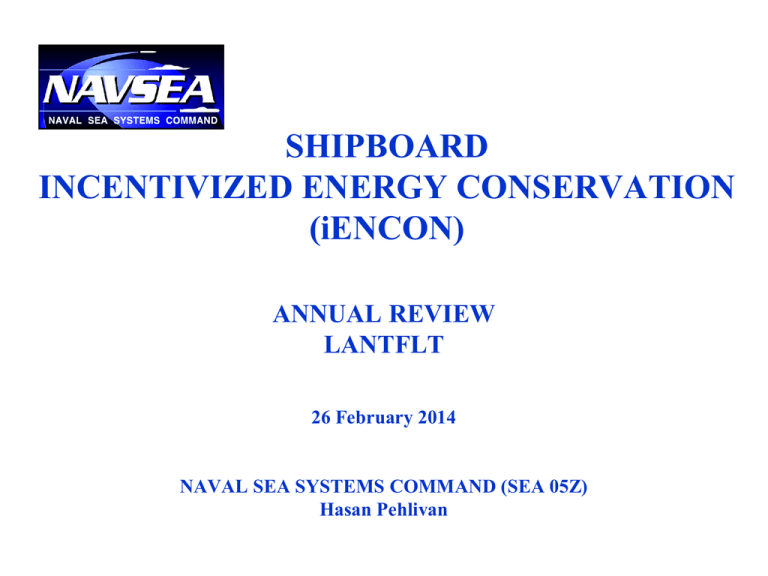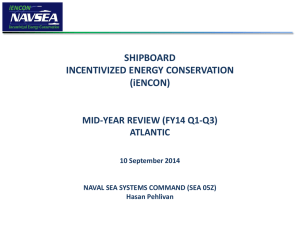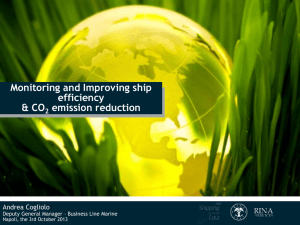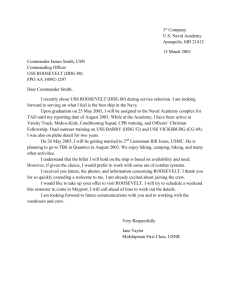iENCON Annual Review
advertisement

SHIPBOARD INCENTIVIZED ENERGY CONSERVATION (iENCON) ANNUAL REVIEW LANTFLT 26 February 2014 NAVAL SEA SYSTEMS COMMAND (SEA 05Z) Hasan Pehlivan How iENCON Works iENCON provides ships energy saving strategies and techniques available by procedural & operational modifications (culture change) iENCON uses BBLs/Hr as metrics to evaluate efficiency of ships and therefore: • results are theoretical engineering efficiency determination • not actual budget allocation • not used for budgetary decisions Ships that underburn offset ships that (overburn) • Since FY 03, underburn has been greater than (overburn) • This allowed TYCOMs do more maintenance, repairs, etc. within same budget TYCOM’s rewards underburning ships with cash incentives to their OPTAR ($1 million/year) Incentives Drive Behavior! 2 iENCON History 1980 NAVSEA’s Shipboard Energy Conservation Assist Training (SECAT) Team conducted underway energy surveys •Lessons learned applied to iENCON •10-15% underburn by procedural & operational modifications 1990 2000 Incentivized ENCON started as pilot program Implemented for all non-nuclear surface ships - 1999 iENCON won Presidential Award – 2002 Fleet net underburn in Black - 2003 iENCON becomes DoD model in effort for branches to deal with spike in fuel prices - 2009 Record underway rate 19.96 BBLs/Hr - 2009 2010 iENCON was a finalist in Platts Global Energy awards - 2010 3 iENCON is a Total Package Education Ship Visits Customer Service Awards iENCON At Work Tools Program Reviews Reports 4 Ship Incentives 1. 2. 3. 4. 5. 6. 7. Fleet Cash Awards SECNAV Energy Awards EPEC and Battle E Awards DOE Energy Awards Top 5 pictures on web site (www.i-encon.com) Top 25 list on web site Good Stewardship of Navy Resources 5 SECNAV Annual Energy Awards – 2013 The following ships received 2013 SECNAV awards for their performance in FY12: Large Ship Category: SECNAV Top Award - USS PELELIU (LHA 5) PAC SECNAV Platinum Award - USS BONHOMME RICHARD (LHD 6) PAC SECNAV Gold Award - USS GERMANTOWN (LSD 42) PAC SECNAV Blue Award - USS KEARSARGE (LHD 3) LANT Medium Ship Category: SECNAV Top Award - USS ROOSEVELT (DDG 80) LANT SECNAV Platinum Award - USS STETHEM (DDG 63) PAC SECNAV Gold Award - USS GRAVELY (DDG 107) LANT SECNAV Blue Award - USS CHOSIN (CG 65) PAC Small Ship Category: SECNAV Top Award - USS NICHOLAS (FFG 47) LANT SECNAV Platinum Award - USS INGRAHAM (FFG 61) PAC SECNAV Gold Award - USS MCCLUSKY (FFG 41) PAC SECNAV Blue Award - USS REUBEN JAMES (FFG 57) PAC DOE Provides Plaque and Certificates to top SECNAV winners 6 WHY iENCON? Helps to achieve SECNAV Goals Increased ENERGY SECURITY Cash awards to their OPTAR SECNAV & DOE Energy Awards, National recognitions Increased mission performance Increased ship endurance range Increased readiness (More fuel for training) Decreased fuel replenishment frequency Decreased machinery maintenance Decreased machinery wear & tear Decreased electric & water consumption Decreased heat stress Reduced air pollution 7 US Navy Fuel Cost Trend 8 SECNAV GOALS FY 2012: Green Strike Group to sail during RIMPAC using 50% energy from alternate fuel FY 2016: Green Strike Group deployed for 6 months using 50% energy from alternate fuel FY 2020: All ships use 50% energy from alternate fuel FY 2020: Ships will use 15% less fuel than baseline (FY 09, 08, 07 average) 9 Q1 FY 14 Results - Overall Overall, ships achieved a fuel cost avoidance of: • 11.48% of total fuel consumed (ENCON Goal 8%) • In theory this translates to: • 221,366 BBLs • 11,098 additional UW steaming hours After paying for ships in (overburn) status (131K) barrels, net 90K barrels in BLACK during Q1 FY 14. In theory, this helped Fleet Commanders accomplish all maintenance, repair, etc. to maintain high fleet readiness within the same budget. More underway steaming = HIGHER FLEET READINESS 10 Q1 FY 14 Results - LANTFLT LANTFLT achieved a fuel cost avoidance of: • 11.42% of total fuel consumed (iENCON Goal 8%) • In theory this translates to: • 118,315 BBLs • 6,269 additional UW steaming hours After paying for ships in (overburn) status (64K) barrels, net 53K barrels in BLACK during Q1 FY 14. In theory, this helped Fleet Commanders accomplish all maintenance, repair, etc. to maintain high fleet readiness within the same budget. More underway steaming = HIGHER FLEET READINESS 11 FY 99–Q1 FY14 Performance UW Fuel Consumption Rate trend is decreasing. During 90’s it was increasing. 12 FY 99-Q1 FY14 Performance GOOD NEWS! UW Fuel Consumption Rate trend is decreasing. During 90’s it was increasing. 13 FY 99-Q1 FY14 Performance 14 FY 99-13 Performance 15 FY 99-13 Performance 16 FY 99-13 Performance 17 iENCON Expanding Influence Task Force Energy Operational/Base Commanders (e.g. control of fuel accounts) Ship Centric Refueling At Sea iENCON Planners/Schedulers (e.g. SOA, Restricted Maneuvering Doctrine) Carriers Shore Power ENCON NAVAIR 18 TFE-NAVSEA Maritime Energy R&D Initiatives Stern Flaps (LHD 1, LSD 41/49 Ship Classes) Combustion Trim Loop (LHD 1 Class) Propeller Coating (Intersleek 900) Solid State Lighting (LHD 1, LHA 6, LSD 41/49, DDG 51 Classes) Shipboard Energy Dashboard (DDG 51 FLT IIA) Directional Stability (LHD 1 Class) Thermal Management Control VSD Port Use Fan (LHD 1 Class) VSD Collective Protection System (DDG 51) Smart Voyage Planning Propeller Roughness High Pressure Turbine Cooling Flow Modification (DDG 51 & CG 47) Optimized Variable Stator Vane Scheduling Energy Storage Module PoC (DDG 51) Hybrid Electric Drive Backfit (DDG 51) Bow Bulb Optimization for DDG 51 CL Triton Fuel Penalty Tool (DDG 51) Advanced Reverse Osmosis Unit (LSD 41/49) AND NAVAIR Alternate Fuel WG: Biofuel (Algae) Development 19 NEW: Operational/Base Commanders Participation Initiatives received from ships COs/CHENGs and ISICs. If Operational/Base commanders use the following initiatives, even more underburn can be gained: 1. The Operational Commanders need to have control of the fuel accounts. • 2. “If not, here is what happens. A ship arrives on a holiday weekend, and is not allowed to enter port because overtime costs exceed the base commander’s budget. So the ship modlocs off the coast waiting for Monday, and at a minimum, burns thousands of gallons a day for 3 days, estimated cost of $250K or more, because $15K was not available for overtime.” Shore Overtime Issues in Norfolk: • During daily training exercises in Norfolk, ships are not able to get underway, conduct their training, and be back in port before the overtime period begins. Since overtime is typically not approved in this scenario, ship’s are forced to steam through the night and come back to port after 0830 the next morning. • Due to insufficient crane and shore power staffing in Norfolk, ships cannot always get connected to shore power before overtime begins at 1530 each day. In this event, the ship is required to aux steam pier side until 0830 the next day so that they can be connected to shore power. 20 NEW: Operational/Base Commanders Participation-cont’d 3. Team effort must exist between Operational and Base Commanders to prevent excessive idle time at sea while waiting to enter port. • • • 4. For example, one action saved taxpayers big. USS Sterett (DDG 104) was allowed to enter port on Friday night with <60% fuel load vice remain at sea to wait for refueling on Monday. Shore command paid $5K in overtime to save taxpayers many times more than that. Maybe a cost sharing policy could be established. RMD. Recommend that ships secure from Restricted Maneuvering Doctrine (RMD) as soon as lines are over and the ship is safely against the pier (unless winds are very high or tugs are unreliable or not available). • • Current practice has been to remain at full power until we are doubled up and the brow is over. This usually takes at least an hour, which burns considerable fuel with 7 engines running. A ship can come down to 2 engines vice 4, and then 1 engine if power is still needed. Additionally, the ship can come down to 2 generators vice 3. 21 NEW: Operational/Base Commanders Participation-cont’d 5. Hull/Propeller Cleaning. • 6. “We need more underwater hull cleaning opportunities. I tried to get one on the way home in Bahrain and Guam, but they were not available. On the way home I was loosing 2 knots on average due to u/w hull growth. I just got my first cleaning in almost 6 months and the divers said I had LOTs of growth on the hull.” Speed of Advance (SOA). • 7. Planners/Schedulers should be energy conscious when assigning a ship’s SOA for transit. If possible, give them the opportunity to use their optimum transit speed and plant alignment. Refueling at Sea. • “CRUDES ships are accustomed to getting on station for a RAS ahead of time, so they are ready to “go along side” as soon as they are called. That means we go to full power (up to 7 engines, ~ 5-6K gallons/hour) waiting to go along side…early. It has been my recent experience that USNS Ships will NOT call us along side until the exact time of the agreed upon RAS…so, we should get the word out to our folks, to NOT go to full power until you are 15-30 min from the alongside time, that will save at least 30 min to one hour of 7 vice 3-4 engines on line prematurely.” 22 NEW: Operational/Base Commanders Participation-cont’d 8. Unnecessary Steaming: • Norfolk’s degaussing range was out of commission for several years. This inevitably forces ships to transit to Groton CT or Mayport FL at a cost of approximately 54K and 80K gallons round trip, respectively, for the sole purpose of running the range. Due to already tight schedules, these ships must often request excess SOA for these transits. • New policy at AUTEC requires ships to perform SSRNMs in groups of 2 or 3 only. This requires ships to transit from Norfolk to the Bahamas for the sole purpose of accompanying another ship to AUTEC. • Large amphibs are required to embark Marines over the beach versus per side in Morehead city because of the cost of overtime at the pier. This evolution can takes up to two days, burns excessive fuel transferring supplies and Marines via Landing Craft, and is taxing on the crew. A pier side embarkment would only take up to 8 hours, would be much less taxing on the crew, and would allow for considerable fuel savings which would more than compensate for the cost of the overtime. 23 CVNs Contributions to iENCON Navy needs CVNs contributions. • In the past year, CVN COs have been included in iENCON correspondence Need support of AIRPAC: • How to provide cash incentives? What action can CVNs take? • • • Use optimum speed for group Who makes decision to allow ships use optimum speeds Allow fleet support to ships in company move independent of CVN 24 iENCON Tasks Conduct iENCON Seminars/Workshops on site and via Video Tele-Training (VTT) classes Support SWOS PCO & PCHENG Classes Conduct iENCON Program reviews with working group at OPNAV, FFC, CNSL, CNSF and CPF Conduct iENCON Program Exec Briefs for OPNAV, FFC, CNSL, CNSF, CPF, and ISICs. Conduct SECAT shipboard underway visits (if money available) Prepare quarterly and annual fuel/award reports Evaluate/recommend ship’s iENCON submittals for SECNAV & DOE annual energy awards Update and provide ships iENCON Tools: NAVSEA Guide, Website, Fuel Curves, ENCON CD, Video, SECAT Software, and ENCON Survey Check List Respond to phone calls and emails from Ships, TYCOMs, ISICs, FFC & CNSL, and CPF 25 SUMMARY 10-15% reduction available by procedural & operations mod (culture change) Incentives and Cash awards are the key • SECNAV & DOE Energy Awards, National recognitions Many reasons for doing iENCON: • Meet SECNAV Goals • Increased Energy Security • Many other benefits Underburn of 751,795 barrels achieved in FY 13 • 9.14% fuel reduction (as compared FY 10-08 average) • 36,955 more underway steaming hours Reduced UW BBLs/Hr trend by average of 25% since FY 1999 Fleet has been in Net Black since FY 2003 Need continued TYCOM, ISIC, Base/Operational Commanders support to maintain success TFE R&D efforts for better efficiency 26








